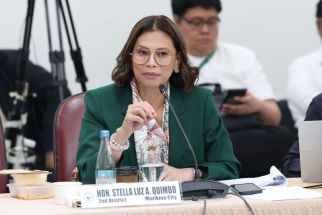How to spend P8.4 trillion

The government’s finance executives are in a frenzy over how to spend tens of trillions of pesos during the remaining three years of the Duterte government.
Failure to do so would greatly affect the success of the government’s P8.4 trillion Build Build Build infrastructure program. Likewise, poor spending or underspending could imperil economic growth targets which, in turn, could weigh down on the goal of bringing the poverty rate to just 14 percent of Filipinos by 2022.
This year, the almost four-month delay in the approval of the 2019 national budget meant not being able to spend almost P1 billion a day for many of the projects that were earmarked for infrastructure building and the delivery of social services.
Thus, for the remaining eight months with the P3.662 trillion national budget signed into law by the President, the national government will be moving hell and high water to accelerate spending and delivery of targeted projects.
It’s going to be a challenging time that will test the efficiency of key government offices like the Department of Public Works and Highways (DPWH) and the Department of Transportation in kick-starting new projects and marshaling workers in building and maintaining roads, bridges, and rails as well as for flood control.
Battling underspending
An underspent budget has always been an issue for the Philippine government, but under Duterte’s economic team, several initiatives had been introduced to instill better fiscal discipline among line agencies and to faster ensure delivery of services to the population.
Under the 2019 national budget, the President ordered the adoption of a cash-based budgeting system where approved spending for goods and services was time-bound for the fiscal year, somewhat following a use-it-or-lose-it policy.
Previously, a multi-year obligation-based budgeting system was in use, which allowed approved allocations to remain valid for up to two years. The Department of Budget and Management (DBM) singled this out as one reason for prevalent underspending among line agencies.
Contracts were signed and used as basis for a budget allocation, but implementation was postponed to the following fiscal year because of problems. Building projects with right of way issues were the best examples.
Reforming the budget process
Cash-based budgeting is one of the proposed disciplines embodied in the proposed Budget Reform Act, which also promises better transparency and accountability in the budget process.
The DBM had started using the cash-based system in its budget consultations as early as 2017. Problems dealing with inspection, verification, fund disbursement, and other operational matters related to budget management have also been discussed with line agencies to further smoothen the process.
Full implementation of a cash-based budgeting system was scheduled this year, but opposition and skepticism in Congress is delaying this to next year. The Lower House had approved the proposed Budget Reform Act last year, but is mulling a recall. The Senate will likely act on the bill during the second half of the year.
Even if the Budget Reform lLaw does not pass this year, the administration’s economic team is bent on implementing cash budgeting to push for an improved gross domestic product (GDP) performance this year up to the medium-term.
Ramping up spending
A more systematic budget system would help ramp up infrastructure and human capital development spending, which had been perennially flagged as one of the lowest in the region. This would help fuel economic growth to between seven percent and eight percent by 2022.
The aim is to move the public infrastructure budget ratio to GDP to 7.3 percent by 2022 from 5.4 percent in 2017 through Build Build Build and the spending ratio for education, healthcare, and social production to GDP to 9.2 percent by 2022 from 8.5 percent in 2017.
In the previous approved national budgets, education and public works usually received the largest allocations – and manifested similarly the worst spending performances. In 2017, for example, the DPWH was able to use only a third of its budget.
This translated to lost opportunity for sectors affected, i.e., roads that would have been used by Filipinos to transport goods and services, or classrooms and school laboratories that would have aided learning of our youth. It also meant lost income opportunities for those willing to work.
Catching up
A study in 2017 warned of the Philippine government’s inability to churn the committed P8.4 trillion budget outlay for Build Build Build during the planned five years, especially if it would ban outright public-private partnerships (PPPs) in projects.
Eventually, PPPs and hybrids were once again recognized for their potential role in supporting economic growth, more so during the interim, while the government was finalizing financing details from China and Japan’s official development assistance commitments.
The DBM is readying the 2020 national budget proposal which has been estimated to reach P4.1 trillion. The Budget Reform Law needs to be urgently passed to facilitate budget allocation and disbursement as more Build Build Build projects come into stream in the next three years and national spending increases correspondingly.
It is not, however, just about professionalized budget procurement and disbursement. Other laws to promote better governance need to be implemented to speed up reforms throughout the bureaucracy.
Only when we have an efficient government can we be assured of continued and sustained economic growth for the country that would benefit the current and future generations of Filipinos.
Facebook and Twitter
We are actively using two social networking websites to reach out more often and even interact with and engage our readers, friends and colleagues in the various areas of interest that I tackle in my column. Please like us on www.facebook.com/ReyGamboa and follow us on www.twitter.com/ReyGamboa.
Should you wish to share any insights, write me at Link Edge, 25th Floor, 139 Corporate Center, Valero Street, Salcedo Village, 1227 Makati City. Or e-mail me at [email protected]. For a compilation of previous articles, visit www.BizlinksPhilippines.net.
- Latest
- Trending




























